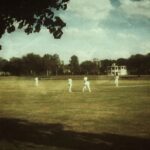Picking The Most Improved Tennis Player Of 2009
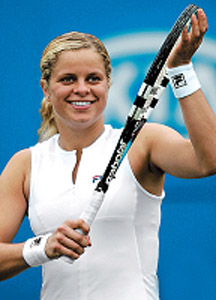
Kim Clijsters went from zero to hero with her improbable run at the 2009 U.S. Open.
From beginning to end, which player in 2009 showed the most improvement? Whether you look at rankings, results, or impact, several players during 2009 advanced the game of tennis and, in the process, themselves.
As you read these entries (arranged in alphabetical order), decide for yourselves who deserves the mantle of “most improved” and cast your vote accordingly.
Which Tennis Player Showed the Most Improvement in 2009?
- Kim Clijsters (17%, 2 Votes)
- Juan Martin del Potro (17%, 2 Votes)
- Robin Soderling (17%, 2 Votes)
- Caroline Wozniacki (17%, 2 Votes)
- Someone Else (17%, 2 Votes)
- Tommy Haas (8%, 1 Votes)
- Samantha Stosur (8%, 1 Votes)
- Taylor Dent (0%, 0 Votes)
Total Voters: 12
1) Kim Clijsters, nominated by Claudia Celestial Girl
From zero to hero? How about from out of (match) condition mother of an 18-month-old, and not even ranked, to qualifier, to Grand Slam winner (USO) in the space of three months, and only three hardcourt events?
In May 2007, Clijsters announced her immediate retirement. She was ranked No. 4 at the time. Only two other players have retired ranked higher: Graf (No. 3), and Henin (No. 1).
In March 2009, she announced that she’d been granted two wild cards to play in the summer North American hard court events: Cincinnati and Toronto. She then played a couple of exhibitions, including one at Wimbledon with Steffi Graf.
She entered her first official post-retirement match in Cincinnati as a WC, and immediately defeated No. 12 Marion Bartoli, and No. 6 Svetlana Kuznetsova. At Toronto she defeated No. 9 Azarenka.
She entered the USO 2009 as a qualifier, unranked. When she entered the rankings on Sept. 14, 2009, she entered at No. 19. She ended the year ranked No. 18.
Final assessment: She popped into the top 20 from nothing, accompanied by a Grand Slam win—like Cinderella coming from cleaning the cinders, popping into the ball, and walking out the door with Prince Charming! That’s a Ferrari-like performance: Going from 0 to 60 in three seconds—or, in the case of a tennis star, from a very high number to a very low number in a very short period of time.
The only counter-argument for how great an “improvement” this represents is that perhaps the layoff for Clijsters did not play as profound a role in her fitness and readiness as it would seem on paper.
2) Juan Martin del Potro, nominated by Shye Sentinele
Juan Martin del Potro’s substantial improvement in 2009 came not in his rise up the rankings but in his ability to win his first major, defeating the world No. 1 Roger Federer in five grueling sets at the U.S. Open, when Federer was aiming for his sixth consecutive title.
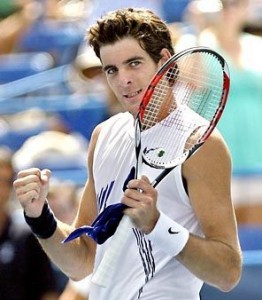
Juan Martin del Potro made a major step forward with his win over Roger Federer at the 2009 U.S. Open.
There was no doubt that the Argentine was a major talent. At the end of 2008, del Potro was the youngest player to be ranked in the top 10. He had won four titles in 2008 and needed to take the same next step as Andy Murray—winning his first major.
He started 2009 by winning the Heineken Open in Auckland, New Zealand. At the Australian Open the Argentine advanced to the quarterfinals, where he was summarily dismissed by Federer, 6-3, 6-0, 6-0. It was an embarrassing defeat for the No. 8 seed, who took away from the match that he had much left to learn about winning a major.
At Indian Wells, seeded six, del Potro lost to world No. 1 Rafael Nadal in the quarterfinals. But he managed to defeat Nadal the next week, at the Sony Ericsson tournament in Miami, during the quarterfinals. The Argentine came back from a double break down in the third set to defeat Nadal for the first time in five meetings.
His ranking moved up to No. 5.
Del Potro was finding his footing on the European clay and did well advancing through many rounds, invariably losing to higher ranked players in later stages of tournaments. He met and lost to Federer again in Madrid, this time in the semifinals after defeating Murray in the quarterfinals. It was his first defeat of the Scot.
Del Potro continued to make an impact on clay, making it all the way to the semifinals of the French Open, where he lost to the eventual champion Roger Federer in five close sets. It was the first time the lanky Argentine had ever taken a set off the Swiss. He was learning what it took to defeat Federer.
The Argentine went out quickly on the grass—still a surface he had not mastered. On hardcourts del Potro successfully defended his Washington title, winning his second tournament of the year. He made it to the finals of Montreal by defeating Nadal, who was making a return to action after a long layoff. He lost in the finals to Murray and withdrew from Cincinnati because of fatigue.
It was at the U.S. Open where del Potro accomplished his impossible dream, by defeating Federer for the first time in his career by coming back in the fifth set and winning his first major. It was an amazing two-week run for the Argentine, who defeated both the No. 1 and No. 2 seeds to take the championship.
The win seemed to take the wind out of the Argentine’s sails for a time. But he came back in the World Tour Finals in London to defeat Federer again and make it to the finals, when he met defeat at the hands of a red-hot Nikolay Davydenko.
He ended the year ranked No. 5 with his first Grand Slam victory under his belt. His improvement on the year was the greatest because he learned how to defeat the top-ranked players in the world and he took his first major at the tender age of 20.
3) Taylor Dent, nominated by Claudia Celestial Girl
Lay back.
Go ahead. Get comfortable. Stare at the ceiling. Look at it long and hard.
Now imagine you are Taylor Dent.
It’s March 19, 2007, and you’ve had yet another back surgery. You are in the hospital. You used to be a professional tennis player. You haven’t played in a year. Are you ever going to get back out there? Who knows.
Now imagine it’s late August, 2009. You’ve been playing qualifying tournaments all year, trying to get back to where you were, but it’s tough when you’ve been out for two years. You won the occasional wild card for major tournaments. You were beaten in the first round of both the AO and Wimbledon, but at Wimbledon it was a five-setter. A five-setter.
Hopefully that is a harbinger of things to come. You’ve got a pretty fast serve in your arsenal. The fourth-fastest. Only Andy Roddick, Ivo Karlovic, and Joachim Johansson have been clocked faster than you.
In the first round of the USO 2009, you go against that good-looking Spanish guy, Lopez, and beat him, 4-6, 7-6, 6-3, 7-5. In the second round, you go against another one of those Spanish guys, the one with the weird Russian name: Ivan Navarro. You fight it out with him for hours: 6-4, 5-7, 6-7, 7-5, 7-6.
It is unbelievable. You’re finally on the map again. Following the match you take a victory lap around the stadium. You grab the chair umpire’s microphone to thank the crowd for their support. You’d think that might be the first time that ever happened, because the chair umpire was pretty surprised.
You end 2009 ranked 76. You started 2008 ranked 901. That’s an improvement of 825 ranking points in 24 months—or about 35 per month. A pretty steep trajectory for a tennis player!
4) Tommy Haas, nominated by Marianne Bevis
At the same time Andy Murray was filling the U.K. press with his win at Queens in London, another first was being scored. Tommy Haas was claiming his home tournament in Halle and his first ever title on grass.
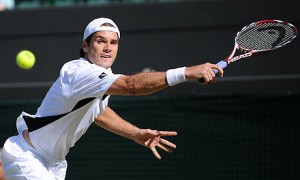
After a dozen years on the Tour, he finally achieved a complete set of wins on all surfaces.
After a dozen years on the Tour, he finally achieved a complete set of wins on all surfaces. What’s more, in taking Halle, he beat Novak Djokovic for the first time.
Haas has been a player of huge talent since he won his first Masters title as a 20-year-old, and he showed more and more of that resurgent talent as spring advanced into summer. Now 31 and one of the oldest men in the main draw, his rise up the rankings must have been the envy of many a competitor who could give him 10 years: from 82 as the season started to inside the top 20.
The seeds of his Halle success were already evident in his outstanding match against Federer in the fourth round of the French Open. Haas stood toe-to-toe with Federer during that five-set marathon, marking his best performance at Roland Garros since 2002.
At Wimbledon, he defeated Djokovic for the second time in three weeks to reach the semifinals for the first time in his career. Once again, he then faced Federer and lost, but this string of success propelled him to a ranking of 19.
The North American swing saw him hold his position with a semi place in Los Angeles and a third-round exit at the U.S. Open, where he once more lost in a tense five-setter, this time against Fernando Verdasco.
His autumn, however, was hit by swine flu, and he retired in both Shanghai and in Stockholm. His premature return in Paris ended, not surprisingly, with an early defeat.
Haas, though, is clearly reveling in his tennis once more, back from a vital confidence-reviving training break early in the year and delighted to be in the top 20 during the autumn of his career.
Had he not missed out on those end-of-season tournaments (which gave him, in some cases, almost 10 fewer events than many of the men above him), he may actually have broken the top 10.
Haas, you see, is used to knockbacks and comebacks. He broke one ankle just as he made the transition from junior to senior status. Within a year, he broke his other ankle. In the run up to the Sydney Olympics, he suffered a bulging disc in his back yet still reached No. 2 in the world.
His progress was brought to an abrupt halt after a severe accident left his father in a coma and Haas taking care of his family. He then missed most of 2003 when a shoulder injury required major surgery.
In 2004, he made a meteoric surge from outside the top 1,000 to No. 17, earning the ATP Comeback Player of the Year award.
In 2005 there was a twisted ankle in the first round of Wimbledon, a wrist injury in 2006, and torn stomach muscles during Wimbledon 2008. More rehabilitation of his troublesome shoulder finally reduced him to an 80s ranking once again.
Such a drop—in his 30th year—might have been the final straw, but that is to underestimate Haas. Here he is, at No. 18, a candidate—if there is any justice in the world—for that comeback award once more. What’s more, he still has ambitions to win his first Slam!
5) Robin Soderling, nominated by JA Allen
Sweden has long been the land of male blond and beautiful tennis players. Led by the enigmatic and immensely popular Bjorn Borg, Mats Wilander quickly followed. Stefan Edberg sprang up instantly behind the wily Wilander and made a name for himself at Wimbledon, where his serve and volley game captured the attention of the media and the world.
As the 1990s turned over into the 2000s, it appeared that the once mighty Swedish contingent was on the verge of extinction. Today Robin Soderling is currently the only male Swedish singles player ranked in the top 200. Swedish tennis officials fervently hope the soaring Soderling is about to alter the fate of Swedish tennis.
Soderling, who turned pro in 2001 and lingered on the fringes, always showed promise but never quite living up to his billing. The Swede chose 2009 to fulfill his destiny with his dominating serves and his powerful groundstrokes, enhanced by a backhand almost as potent as his massive forehand.
Starting the year ranked No. 17, in 2009 Soderling began his climb into the top 10. But he started slow suffering with mediocre results and injuries. He lost in the third round at both Rome to Nadal and then at Madrid to Federer.
At the French Open Soderling was seeded 23 and he reached the fourth round of a major for the first time in his career. His next opponent was Nadal, the reigning champion, owner of the red clay of Roland Garros.
The Swede’s defeat of the French Open champion, going for his fifth consecutive victory on the red clay, 6-2, 6-7, 6-4, 7-6, was perhaps the biggest upset of the decade. Soderling is the only person ever to defeat Nadal at the French Open.
Soderling met and lost to Federer in the final. But the world took notice of Swedish tennis as played by Soderling once again. He climbed to No. 12 in the world after his break out performance at Stade Roland Garros.
At Wimbledon, seeded 13th, Soderling once again faced Federer in the fourth round—again the furthest he had ever advanced on the famous grass courts. Although Soderling lost, 6-4, 7-6, 7-6, the Swede’s serve was only broken once by the Swiss.
After Wimbledon, Soderling went on to win the Swedish Open. He became the first Swede to win his country’s tournament since Magnus Norman in 2000. Soderling moved up to No. 11.
An elbow injury slowed his progress during the American hardcourt season. Seeded 12th at the U.S. Open, Soderling made it to the quarterfinals, again his furthest advancement in this major. Inevitably he lost again to Federer.
It was at the Masters Event in Shanghai where Soderling finally cracked into the ATP top 10. The Swede, however, wished to secure a place in the year-end World Tour Finals in London by being in the top eight. That meant he had to do well in Paris at the Paribas Masters.
Unfortunately, Djokovic defeated him in the quarterfinals and ended Soderling’s chance to finish in the top eight.
Ranked No. 9, however, Soderling was the first reserve and when Roddick withdrew, Soderling stepped in. The Swede made it to the semifinals, losing to del Potro and ended the year ranked as the No. 8 player in the world.
Moving up from No. 17 to No. 8 in the world plus scoring perhaps the biggest upset of the year, maybe even the decade makes Soderling a candidate for the most improved player of 2009.
6) Samantha Stosur, nominated by Shye Sentinele
By the end of 2008, Samantha Stosur had moved her singles ranking up to No. 52 in the world. This ranking was 110 points above where she had been ranked at the beginning of the year. The world-renowned doubles player, teamed with Rennae Stubbs, was beginning to make her mark in the singles arena.
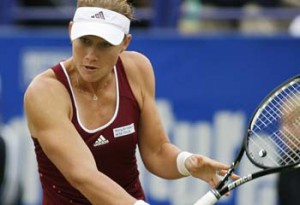
Samantha Stosur has improved to 13th in the world rankings.
As of Nov. 7, 2009, Stosur is currently ranked No. 13 in singles in the WTA. How did she rise so far? For one thing, Stosur was playing singles on a more consistent basis, still continuing her more successful doubles play.
It was at the French Open that the Australian made her mark, making it all the way to the semifinals, where she faced the eventual champion in Kuznetsova, losing in three sets. This finish ushered Stosur into the top 20 in singles for the first time in her career.
Stosur had modest results on grass but held her ranking nonetheless.
During the U.S. Open series, the Australian made it to the semifinals at Stanford, upsetting No. 1 seed Serena Williams. She lost to Marion Bartoli seeded No. 8. At the LA Women’s Championships, Stosur made it to the finals where she lost to Flavia Pennetta, the No. 10 seed.
At Toronto, Stosur defeated Kuznetsova before falling to eventual champion Elena Dementieva in the quarterfinals. With her hardcourt results, the Australian moved up to No. 15 in the WTA singles rankings.
She was seeded No. 15 at the U.S. Open but lost in the second round. In September, Stosur’s ranking improved to No. 13. In Osaka she won her first WTA tournament in singles defeating Frances Schiavone in the final.
Stosur qualified for the 2009 Commonwealth Bank Tournament of Champions in singles and at the WTA Tour Championships with doubles partner Rennae Stubbs.
With her tremendous serve and her serve-and-volley style of play, Stosur is a handful for any opponent to contain. Her kick serve has been clocked regularly at over 118 miles per hour.
She is very athletic and her game is vastly improving, as her rankings show. More than any other player on the women’s tour, Stosur’s improvement must rank right up there at the top.
7) Caroline Wozniacki, nominated by JA Allen
You knew good things were in store for Caroline Wozniacki when she won newcomer of the year in 2008 and finished the year ranked world No. 12. At age 18, there didn’t seem much out of reach for the Danish sensation.
Wozniacki can be aggressive with a firm grip on her game and an acute understanding of the opposition’s strategy. The Dane works over her opponent, moving her around until Wozniacki has her just where she wants her before finishing off the point.
Wozniacki is also a tremendous defender, scrambling to track down every ball and get it back over the net.
Her true power, however, lies in her mental strength. Wozniacki cannot be accused of choking. She just settles into the game no matter what the score and does what she needs to do to win.
At the 2009 Australian Open, Wozniacki advanced to the third round, losing in three sets to Jelena Dokic, a wild-card entry.
Seeded No. 1 at the Cellular South in Memphis, Wozniacki lost to Victoria Azarenka in the final. She advanced to the quarterfinals at both Indian Wells and Miami, losing to Vera Zvonereva and Kuznetsova, respectively.
Wozniacki won her first tournament of the year on the green clay of Ponte Verde Beach. She did not fare quite so well on her next outing at the Family Circle Cup, losing in the finals to Sabine Lisicki.
Reluctant at first on the clay, Wozniacki did much better than she expected. She met world No. 1 Dinara Safina in the finals of Madrid but lost. The Dane advanced to the third round of the French Open, losing to her good friend Sorana Cirstea.
Moving on to grass, Wozniacki won her second title of the year at Eastbourne, defeating Virginie Razzano in the final, 7-6, 7-5. Seeded ninth at Wimbledon, the Dane reached the fourth round before being bounced by Sabine Lisicki once again.
Wozniacki had moderate success during the summer hard court season. She did successfully defend her Pilot Pen title in New Haven, beating challenger Elena Vesnina in the final for her third win of the season.
But it was the 2009 U.S. Open that catapulted Wozniacki up the rankings. She made it all the way to the final where she faced the unseeded Clijsters. Wozniacki lost that final but became the first Danish woman ever to play in a Grand Slam championship match.
The win propelled her to the No. 6 ranking. It also meant that the young Dane qualified for the WTA Tour Championships in Doha.
Trying to overcome both illness and injury, Wozniacki hobbled into Doha, where she still managed to make it to the semifinals. She ended up retiring while playing Serena Williams, trailing 6-4, 0-1.
Wozniacki ended the year ranked No. 4, having firmly established herself in the top 10. She is poised to take on the top women on tour in 2010. Wozniacki is one of the most improved players of 2009.
Be sure to vote for your pick in our survey or let us know in the comments the player who should have been included that we overlooked!

